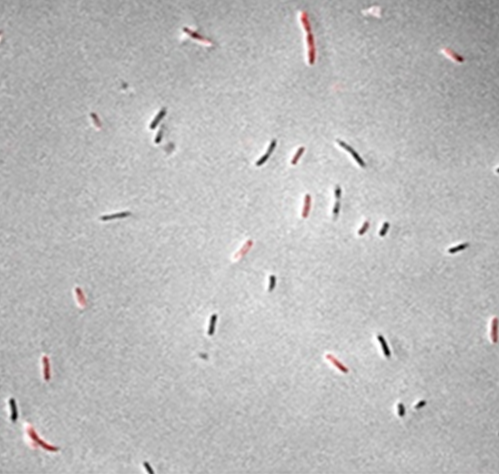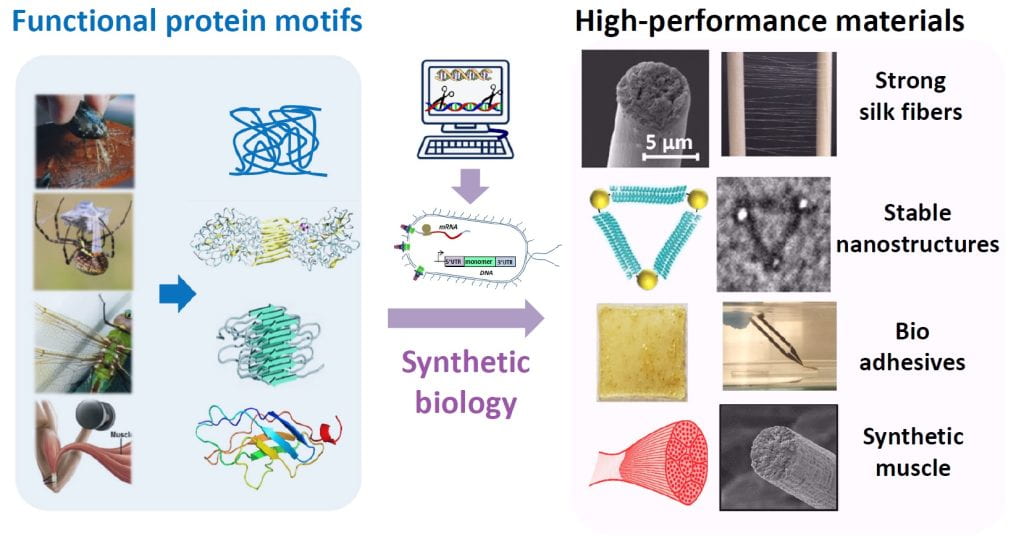Our research focuses on engineering microbial cell-based systems to perform complex tasks and to produce renewable fuels, chemicals, and advanced materials.
1. Metabolic Dynamics and Heterogeneity : (synthetic biology, metabolic engineering)
Nature uses a suite of delicate regulatory systems to control both gene expression and pathway flux in response to environmental signals. When engineering microbial cells to produce fuels, chemicals, and materials, it is important to rewire the natural regulatory network, which was evolved for cell growth and replication, but not to over-produce any target compound. We are interested in developing tools to dissect the complex regulatory network of natural systems and to design synthetic regulatory systems that allow cell to control engineered pathways dynamically (Fig left). In addition, non-genetic, cell-to-cell variations in protein and metabolite concentrations cause large heterogeneity in single cell biosynthetic performance and dramatically affect ensemble product yields and titers (Fig right). We are interested in understanding the origin of metabolic noise and developing tools to regulate metabolic variation.


Representative papers:
Han Y., Li W., Li J., Zhang F.* Genome-wide promoter responses to CRISPR perturbations of regulators reveal regulatory networks in Escherichia coli. Nat Commun, 14, 5757, doi.org/10.1038/s41467-023-41572-4, (2023).
Hartline C., Schmitz A., Han Y., Zhang F.,* Dynamic control in metabolic engineering: theories, tools and applications. Metab Eng. 63, 126-140, (2021).
Liu D, Zhang F., Metabolic Feedback Circuits Provide Rapid Control of Metabolite Dynamics. ACS Syn Biol. 7 (2), 347–356, doi: 10.1021/acssynbio.7b00342 (2018).
Schmitz AC, Hartline CJ, Zhang F, Engineering Microbial Metabolite Dynamics and Hetergeneity. Biotech J . (2017) doi: 10.1002/biot.201700422.
Xiao Y., Bowen C., Liu D., Zhang F., Exploiting nongenetic cell-to-cell variation for enhanced biosynthesis. Nat Chem Biol. 12, 339, doi.org/10.1038/nchembio.2046, (2016).
Liu, D., Xiao, Y., Evans, B., Zhang, F., Negative feedback regulation of fatty acid production based on a malonyl-CoA sensor-actuator. ACS Synth Biol. 4, 132, (2015).
2. Synthetic Biology for Advanced Materials
Most synthetic polymers are currently derived from petroleum. Increasing concerns over petroleum’s environmental impacts and declining supply demand the development of state-of-the-art technologies to manufacture polymers from renewable feedstocks. On the other hand, nature has evolved various types of materials with delicate nano-scale structural that endow desirable material properties at the macro-scale. We are interested in developing synthetic biology platforms to largely expand the synthetic power, producing high-performance materials with properties beyond their natural counterparts or with novel functions, enabling applications (sensing, protection, scaffolding, catalysis, etc.) not possible with existing materials. Published examples include microbially produced spider silk fibers that are as strong and tough as natural spider silk and mussel foot proteins (Mfps) with higher underwater adhesivity than natural Mfps.
 Representative papers:
Representative papers:
Li J., Jiang B., Chang X., Yu H., Han Y., Zhang F.*, Bi-terminal Fusion of Intrinsically Disordered Mussel Foot Protein Fragments Boosts Mechanical Strength for a Wide Range of Protein Fibers. Nature Communications, 14, 2127, doi: 10.1038/s41467-023-37563-0. (2023).
Bowen C.H., Sargent C.J., Wang A., Zhu Y., Li J., Chang X., Mu X., Galazka J.M., Jun Y., Keten S., Zhang F.* Microbial Production of Megadalton Titin Yields Fibers with Advantageous Mechanical Properties. Nature Communications, 12, 5182, doi: 10.1038/s41467-021-25360-6 (2021).
Li J., Zhu Y., Yu H., Dai B., Jun Y., Zhang F.* Microbially Synthesized Polymeric Amyloid Fiber Promotes β-Nanocrystal Formation and Displays Gigapascal Tensile Strength. ACS Nano, 15, 7, 11843–11853, (2021)
Bai W., Sargent C.J., Choi J., Pappu R.V., Zhang F.*, Covalently-assembled, single-chain protein nanostructures with ultra-high stability. Nature Communications, 10, 3317. doi: 10.1038/s41467-019-11285-8 (2019).
Bowen C.H., Dai B., Sargent C.J., Bai W, Ladiwala P, Feng H., Huang W, Kaplan D.L., Galazka J.M., Zhang F.*, Recombinant Spidroins Replicate Mechanical Properties of Natural Spider Silk. Biomacromolecules, 19 (9), 3853–3860 (2018)
3. Advanced Biofuels and Chemicals (metabolic engineering & synthetic biology)
To meet the increasing demands of sustainable transportation energy, we aim to engineer microbes to produce advanced biofuels that could be readily used in current engines. One of the biggest challenges is to biosynthesize non-natural molecules that have structures exactly the same or highly similar to the fuels currently derived from petroleum. We are interested in constructing novel metabolic pathways to produce these compounds. In addition, we are also developing synthetic biology tools to improve the titer, yield, and productivity of the advanced biofuels.

Representative papers:
Bai W., Anthony W.E., Hartline C.J., Wang S., Wang B., Ning J., Hsu F., Dantas G.*, Zhang F.*, Engineering Diverse Fatty Acid Compositions of Phospholipids in Escherichia coli. Metab. Eng., 74, 11-23, doi: 10.1016/j.ymben.2022.08.011.(2022)
Jiang W., Qiao J.B., Bentley G.J., Liu D., Zhang F., Modular pathway engineering for the Production of Branched-Chain Fatty Alcohols. Biotechnol Biofuels. 10:244. doi: 10.1186/s13068-017-0936-4. eCollection (2017).
Bentley G.J., Jiang W., Guamán L.P., Xiao Y., Zhang F., Engineering Escherichia coli to produce branched-chain fatty acids in high percentages. Metab Eng. 38, 148, (2016).
Bowen C., Bonin J., Kogler A., Barba-Ostria C., Zhang F., Engineering Escherichia coli for conversion of glucose to medium-chain ω-hydroxy fatty acids and α,ω-dicarboxylic acids. ACS Syn Biol. 5, 200, (2016).